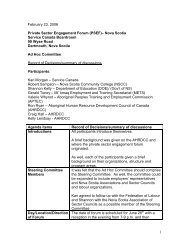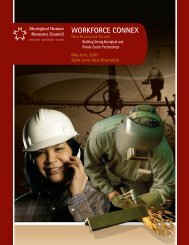THE DISCUSSIONParticipants shared ideas about how to increase <strong>Aboriginal</strong> participationin trades and apprenticeship in the Manitoba region. The dialogueand deliberations at the session are contained below.WelcomeKelly Lendsay, AHRC President and CEO welcomed all participants, gave specialthanks to the elders, and introduced the dignitaries who offered opening remarks.Opening RemarksThe following leaders provided opening remarks and wished the participantswell as they completed their work for the day and a half session:•••••Minister Kerri Irvin-Ross, Minister of Healthy Living, Manitoba GovernmentGrand Chief Ron Evans, Assembly of Manitoba ChiefGrand Chief Morris Shannacappo, Southern Chiefs OrganizationGrand Chief Sidney Garrioch, Manitoba Keewatinook Ininew OkimowinPresident Lionel Chartrand, <strong>Aboriginal</strong> <strong>Council</strong> of WinnipegPART 1: Market OverviewJohn Harper, Labour Mobility Coordinator and Labour Market Analyst,Competitiveness, Training and Trade, Government of Manitoba, gave apresentation on the Manitoba labour market. The main points include:• The population in Manitoba is rising; 14 per cent of thetotal population is <strong>Aboriginal</strong>, and growing.••The population is aging as the baby boom moves through.Post secondary enrollment is up but peaking.• International immigration is strong and interprovincialimmigration is improving.• Over $13 billion of construction projects to beginin Manitoba over the next six years.• There is very little unused labour in Manitoba; unemployment rate isamong the lowest in the country; 12.1 per cent for First Nations and 7.9per cent for Métis compared to 4.1 per cent for the general population.• Education attainment for <strong>Aboriginal</strong> Manitobans islower than it is for the general population.• Of the 80 highest demand occupations in Manitoba, half are in the healthcare, trades, transportation and equipment operators occupation groups.The full text of this presentation can be found on the<strong>Workforce</strong> Connex website @ www.workforce<strong>connex</strong>.comPART 2: Walk in my Shoes / Moccasins -A Personal ConnectionIn an effort to better understand each other’s challenges, the participantsreversed roles whereby the employers were asked to think and act like theywere members of the <strong>Aboriginal</strong> community or AHRDA group, while the <strong>Aboriginal</strong>community and AHRDAs were to think and act like they were employers.A summary of the conversation is as follows:AHRDAs as businesses:Question asked… If you were a business, whatchallenges would limit your ability to make positiveconnections to the <strong>Aboriginal</strong> Community?Below is a summary of points identified (and recorded) by eachof the groups representing the supply side conversation. Thethoughts have been organized into the following themes:•••••••Communication and AwarenessEducation, Training and SkillsInstitutional BarriersCultural FactorsSpecific Needs of IndividualsRacism, Stereotypes and MisperceptionsOther Challenges and Barriers.Communication and Awareness••••We don’t advertise – tend to use word of mouth.People do not know what resources are available and how to access them.There is a lack of communication with the Aborginal community.Where do we advertise to get <strong>Aboriginal</strong> candidates?• Lack of compassion and understanding of wherethese people are coming from.••Lack of resources to locate <strong>Aboriginal</strong> people.Do not have full understanding of <strong>Aboriginal</strong> communities.• To raise awareness about barriers. Use as mentors, peoplewho have had to overcome barriers in the community.Education, Training and Skills••Aborginal people need life skills.<strong>Aboriginal</strong> people do not have enough education.• In order to move up in an organization a grade 12diploma is required for the majority of jobs.••There is a lack of communication skills.Need pre-training skills and requirements.• Must leave the community for training and there is extra costsassociated with leaving home to acquire this training.6<strong>Aboriginal</strong> <strong>Human</strong> <strong>Resource</strong> <strong>Council</strong>Manitoba <strong>Workforce</strong> Connex Report
••Need an <strong>Aboriginal</strong> employee network in the organization.There is long-term vs. short-term work.• Once they are trained they are financially incapableof retaining and they go back home.•••••They are not job ready.Need to develop career plans.Provide career planning to youth.There is a skills gap.Need to balance the need for experience vs. education.• There are opportunitities to train skills (i.e., getting <strong>Aboriginal</strong>people to feel comfortable with eye contact).•Need support for education.• Training is offered once in the position (orientation, new staff toorganization and job). Too little development through a career.••••••They are lacking in resume and interviewing skills.Need to offer more counselling and training.They have a lack of experience (need more).Need good references.There is a lack of training programs (need more).They must travel to the job (and leave communities).Institutional Barriers•Have difficulty recruiting <strong>Aboriginal</strong> people to the jobs.• There are implications of relocation – housing, andtransportation – they don’t want to relocate.•••They feel more comfortable elsewhere.Looking for people who are more aggressive in selling product(s).Want people who have a willingness to take chances.• Lack of transportation (worker is unequipped with avehicle or cannot find alternate transportation).• In the interview process some questions are notappropriate and culture needs to be considered.•Need adequate housing.• Must concentrate on retention of <strong>Aboriginal</strong> employees(people quit their supervisor, not the business).•Need to provide tools and equipment.• Hiring entry level–type positions -- low wagesand unable to provide sufficient pay.•••There are policy and procedure barriers.No access to childcare services.‘Been there, done that and it didn’t work’ type of attitude.••Union limits in pay equity based on seniority.Jobs outside of community – mobility issues.Cultural Factors••••••••••Isolated communities.Need mentoring and support in communities to move to the city.Some <strong>Aboriginal</strong> people don’t fit into the culture of business.‘Not a charity’ – only hire qualified people.Culture shock.Language (accents) – English is not always the first language.Social ills (i.e., alcohol and drugs).Lack of role models and references.Educating management on culture and workers’ acceptance.Not aware of cultural differences.• Cultural factors (i.e., misunderstanding about taking timeoff work due to traditional ceremonies and hunting).Specific Needs of Individuals•••••••••Lack skills and experience.Lack of transportation and accommodations.Lack of childcare services.Lack of confidence and self-esteem.Substance abuse.Overwhelming family issues (become overwhelmed).Don’t know what is expected.Not applying for jobs.Social - drug abuse -- abuse cycles.• Financial challenges (i.e., not having appropriatedress attire for interviews and jobs).•••••••••Fear of failure.Afraid to ask for help.Sense of loneliness and isolation.Lack of empowerment (dependent vs. independent).Lack of a driver’s license and vehicle.Need to project a professional image (i.e., clothing etc.).Need orientation and need to develop a game plan.May not be willing to relocate.Lack of interview skills.• Criminal records.<strong>Aboriginal</strong> <strong>Human</strong> <strong>Resource</strong> <strong>Council</strong> Manitoba <strong>Workforce</strong> Connex Report 7









